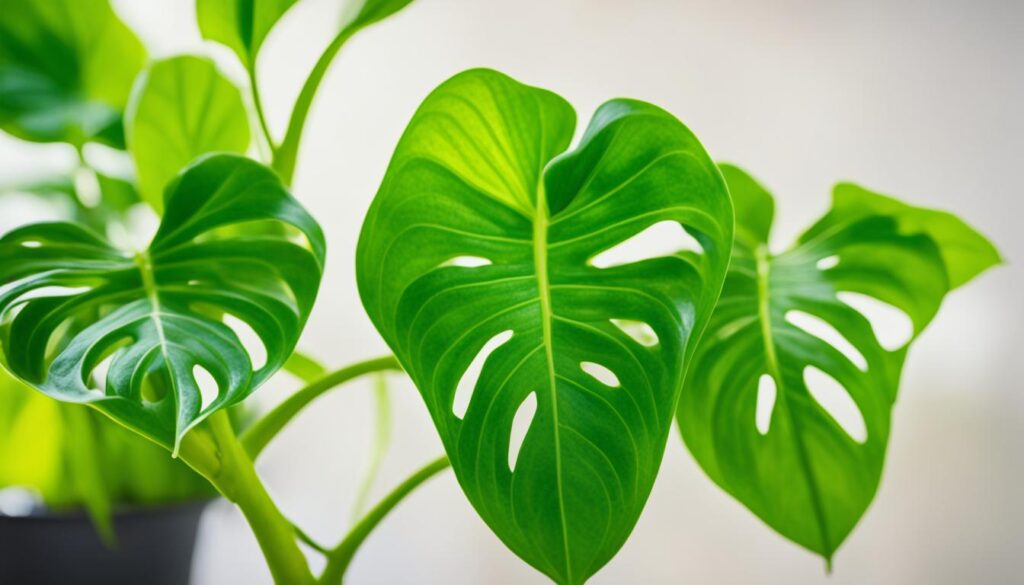Houseplants make our homes feel happy by bringing the outdoors inside. Besides, they give us a link to nature. Yet, buying too many can be costly. A great way to save money is to grow plants from your current ones. This process is called propagating.
Key Takeaways
- Propagating heartleaf philodendron is an easy and cost-effective way to expand your plant collection.
- The best time to propagate is in the spring or summer, but it can also be done in the fall or winter.
- Roots may take 3-4 weeks to appear on stem cuttings, and they should be at least 1 inch long before planting in soil.
- Heartleaf philodendron can be propagated using either the water or soil method, depending on your preference.
- Proper care, including light, humidity, and watering, is crucial for the success of your propagated plants.
Identifying Heartleaf Philodendron
Propagating pothos and philodendron is similar in many ways. But, it’s fascinating how they differ. These differences help us take better care of our plants.
Leaf Shape and Texture
The heartleaf philodendron is known for its heart-shaped leaves. They shine brightly and feel smooth like velvet. The edges of the leaves are a bit wavy, making them look even more lovely.
Growth Patterns and Stem Structure
The heartleaf philodendron grows as a vine or climbs as it spreads. It can become quite long. Its stems might turn red or purple over time. When older, these stems get woody and grow roots that help them hold onto things.
Pothos, on the other hand, tends to stand more upright. Its leaves are large and have a different feel. Unlike a philodendron, a pothos does not need to climb as much. It can handle its own weight well.
Pothos vs. Philodendron: Spotting the Differences
Propagating pothos and philodendron can seem alike at first. But, it’s interesting to see the small differences between these two favorite houseplants. Knowing these differences improves your gardening and care for them.
Philodendron hederaceum var. oxycardium and Epipremnum aureum both climb and belong to the Araceae family. They both have shiny, green leaves that are about the size of an adult’s hand. Yet, there are crucial differences you must remember:
| Characteristic | Pothos | Philodendron |
|---|---|---|
| Leaf Texture | Thicker, waxy, and bumpy | Thinner and smooth |
| Leaf Shape | Spade-like, can be asymmetrical | Heart-shaped with a distinct sinus and tailed apex |
| Leaf Growth | Extend and unfurl from a current leaf | Grow on a bit of vine in a cataphyll |
| Stem Structure | Thicker, similar color to leaves | Greenish-brown or orangey-brown near the bottom |
| Aerial Roots | Thick nubs, one per node | Thin, spindly, grow in groups of 2-6 |
| Genus | Epipremnum | Philodendron |
| Leaf Color | Marked with gold, white, or yellow | Plain green |
| Growth Rate | Up to 12 cm per week | Up to 10 cm per week |
| Light Tolerance | Can tolerate lower light better | Prefer warmer climates |
| Humidity Preference | Higher humidity | Lower humidity |
Learning these differences between pothos and philodendron helps you take better care of them. This way, they’ll grow well and add special beauty to your space.

Tools and Materials Needed
You’ll need a handful of key items to propagate heartleaf philodendron successfully.
Sharp Pruning Shears
Get yourself a top-notch pair of sharp pruning shears. They’re crucial for making clean cuts on your philodendron stems. This helps them root quicker with less damage. Choose shears that are gentle on plants for a neat cut.
Clean Containers
For rooting philodendron cuttings, pick clean, sterilized containers. Glass jars and mason jars, or small plastic ones, are great. Make sure these containers are spotless to avoid spreading diseases.
Rooting Hormone (Optional)
Using a rooting hormone is optional but can be beneficial. It boosts root growth, speeding up the whole process. For the best results, go for an organic rooting hormone especially made for indoor plants.
how to propagate heartleaf philodendron
To propagate heartleaf philodendron, start by choosing healthy stem cuttings. Pick them from a mature plant that’s free from disease. Look for stems with lots of leaves and nodes. These are important for new roots to grow.
Selecting Healthy Stem Cuttings
When choosing heartleaf philodendron stem cuttings, avoid any damage or disease. Select stems that are about 4-6 inches long. They should have 3-4 leaves and several nodes. Nodes are where leaves and roots will come out.
Preparing the Cuttings
After selecting your heartleaf philodendron stem cuttings, it’s time to prep them. Use sharp and clean pruning shears to cut just below a node. This ensures your cutting has at least one node. Take off the lower leaves. Keep the top 2-3 leaves. This helps the cutting concentrate on growing roots.
You can also use a rooting hormone to help roots grow faster. But using rooting hormone is up to you. Heartleaf philodendron cuttings can often root well without it.
Now, with your cuttings ready, it’s time to proceed to propagation. This will help your heartleaf philodendron grow strong and healthy.
Water Propagation Method
The water propagation method is perfect for the heartleaf philodendron. It lets you watch the roots grow in a safe space. You can see how the plant is doing without disturbing it.
Creating a Rooting Solution
Start with a clean glass jar and add fresh, dechlorinated water. You can boost root growth by mixing in some rooting hormone. It’s also a good idea to use a bit of activated charcoal to prevent bacteria.
Monitoring Root Development
Put your philodendron cuttings in the water, making sure the ends are wet. They should go in a sunny place but not in direct sunlight. Check the water often, and top it up when needed. After a week or two, roots should begin to appear.
When the roots are about an inch long, move your heartleaf philodendron to soil. This works great for velvet leaf philodendron, Philodendron ‘Brasil’, and Philodendron brandtianum. These varieties can take 4-6 weeks to form enough roots in water.

Soil Propagation Method
If you like to propagate your heartleaf philodendron in soil, here’s how:
Choosing the Right Potting Mix
Choose a potting mix that drains well and is rich in nutrients. It’s specially made for houseplants. This mix helps your philodendron cuttings grow by keeping the right amount of air and water. Don’t use regular garden soil because it might have pests or diseases.
Planting the Cuttings
Get your planting pots ready with the potting mix. Put the philodendron cuttings in gently, making sure the nodes are all covered. Remember to leave some space between each cutting. This helps their roots grow well.
Maintaining Moisture Levels
It’s important to keep the soil damp but not too wet while your cuttings grow. Use a fine mist from a spray bottle to water them. This keeps them from being moved around too much. Always check the soil. Add water when it’s needed to keep it just right. With good care, you could see X% success in growing your new plants from soil. The roots should start growing in about Y days. In the end, you could have Z new plants this way.


